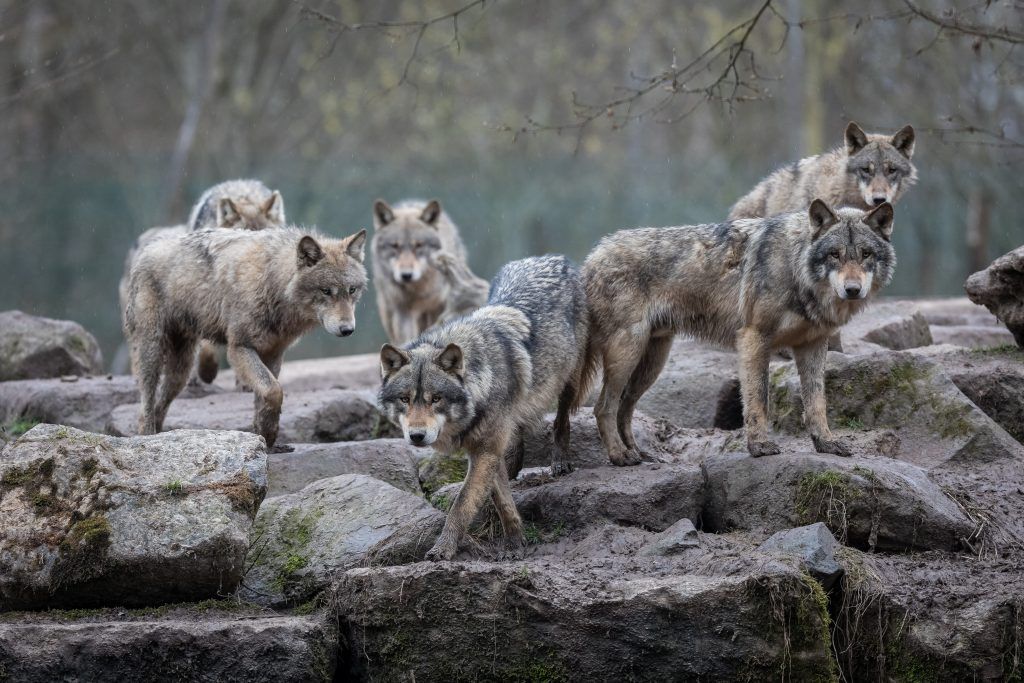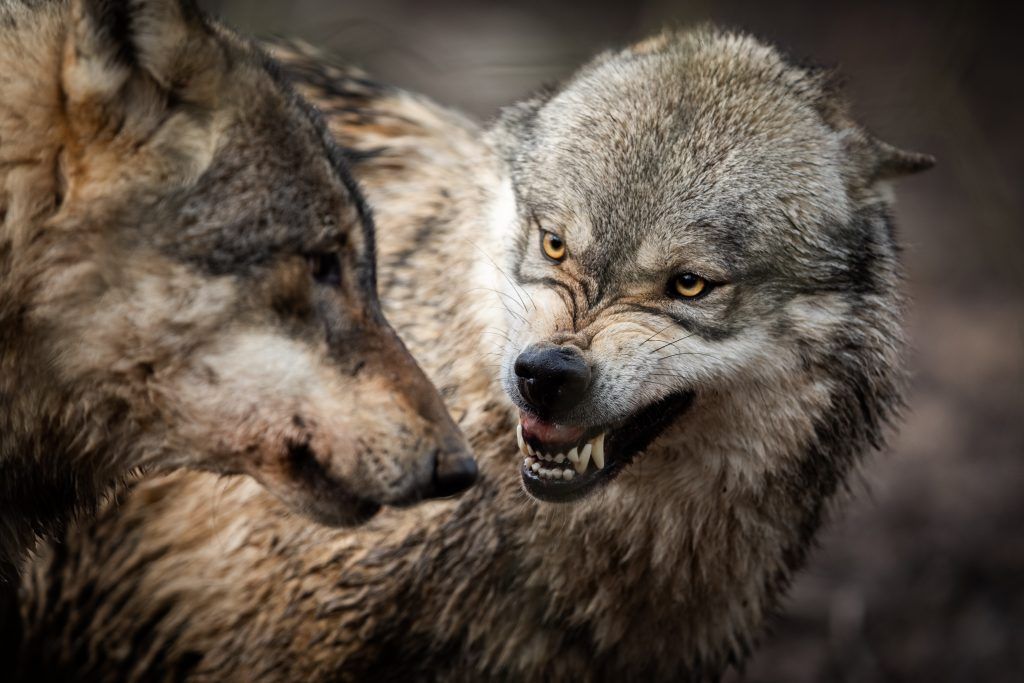Very few dog breeds resemble a wolf as closely as the German Shepherd. The only one that comes to mind as a potential closer match is the Czechoslovakian Vlcak.
Many sources claim that the German Shepherd breed has a 99% DNA match with wolves – which is true but misleading. Domestic dogs, in general, share 98.8% of the same DNA as wolves, making the match with German Shepherds less impressive than that statistic on its own initially appears to be. As an additional fun fact, the Shih Tzu breed is the breed with the highest DNA match to their wild wolf ancestors.
So why is it that German Shepherds look so much more wolfish than others? After all, they have a similar shape, size, stature, and even body language. Most likely because wolf-hybrids were used in the breed’s creation.
Breed History

Wolves are ancient animals that have existed for millions of years, with the first members of the group originating around 40 million years ago. Gray wolves, the ancestor of all domesticated dogs according to researchers, first appeared around 1 million years ago.
Wolves today are still wild animals that live in packs and hunt for their food, as well as scavenging when necessary. They have adapted to many different environments and climates, ranging from the cold Arctic to the hot, sunny desert. Wolves are also highly social creatures and communicate with each other using body language, vocalizations, and scent marking.
Gray wolves, the ancestor of all domesticated dogs according to researchers, first appeared around 1 million years ago
By comparison to wolves and even other domestic breeds, German Shepherds are an extremely young breed, developed in the late 19th century by a German captain named Max von Stephanitz. He set about creating a versatile working dog that could perform various tasks such as herding and guarding, as well as having the ability to serve in the military and police. He crossed various local sheepdogs depending on their desirable traits, selecting only the best specimens for his breeding program.
According to the book “Der Deutsche Schaferhund in Wort Und Bild,” written in 1923 by Max Von Stephanitz himself, the wolves were used in the original breedings as well as 3 wolf-dogs.
The result, of course, was the German Shepherd, a loyal, intelligent, and obedient dog that quickly gained popularity around the world.
Modern German Shepherd Wolf-Hybrids
Wolf-hybrids, or wolf-dogs, have become more common than a lot of people think. Naturally, the more rugged, wolf-like breeds are often used, such as Siberian huskies, Alaskan Malamutes, and, of course, German Shepherds.
One interesting example of this is the recently popularized Blue Bay Shepherd, which was first produced using blue-coated European line German shepherds and eastern timber wolves as part of the breeding foundation. Another one is the Lycan Shepherd, which I’m waiting to hear more information about.
Size
Wolves are typically larger and heavier than German Shepherds. The average weight of a male wolf is between 80 – 100 pounds, though some gray wolves can grow as large as 180 pounds. The average weight of a male German Shepherd, on the other hand, is around 66 pounds, and they rarely eclipse 100 pounds. Mine hovers between 92 and 98 pounds, and he is definitely on the larger side, though nowhere near the size of a large gray wolf.
Weight is not the only size difference between these two canines; they differ in height and length as well. Wolves are, on average, only 2-6 inches taller than a German Shepherd, but they are substantially longer. Most German Shepherds don’t reach over 42.5″, not including the tail, while wolves are around 48″ long, also not including the tail. Some exceptionally large wolves can even be as long as 60″, a whopping 5 feet!
These numbers may vary from individual to individual as well as between different species of wolves. The numbers here are based on gray wolves.
Personality
It should come as no surprise that wolves and dogs have distinct personality differences, one being wild and the other domesticated.
German Shepherds are well known as friendly, loyal, and affectionate dogs toward their owners and family. As a product of their breeding, they are also eager to please, alert, and protective, making great watchdogs and guard dogs. They are also often good with children and other pets as long as they are properly trained and socialized at a young age.
In stark contrast, wolves are shy, wary, and independent animals that do not often trust humans or other animals easily. They are not suitable as pets either, requiring a lot of space, exercise, and stimulation. By instinct, they are also very territorial and dominant, making them prone to aggression and conflict. Another byproduct of their distrust of humans is they do not learn, listen to, or follow commands easily, making them highly difficult to train.
Temperament

As a herding/guard breed, German Shepherds tend to be calm, confident, and courageous dogs in all types of situations. Though they are not aggressive by nature, they will quickly defend themselves, their owners, and their property without hesitation.
German Shepherds are also wary of new people, so if you bring home a new pet or have strangers over, they may take time to warm up, and proper introductions are essential.
Wolves are quite the opposite. They are nervous, fearful, and unpredictable animals. They do not adapt well to changing environments and often suffer from stress or anxiety. Leading to abrupt, unexpectedly violent reactions – typically attacking anything they view as either threat or prey.
Diet
At it’s basic level, wolves and German Shepherds share the same diet. They are both facultative carnivores. Meaning they both primarily eat meat but have the ability to consume some plant matter for supplemental nutrition.
After taking down a large game animal, wolves can eat as much as 20 lbs of meat in one sitting
The difference lies in how they get their food. In most cases, German Shepherds are given commercially prepared kibble by their owners. It’s usually formulated with one or two types of meat (protein), as well as other vitamins, minerals, and plant matter, to make a completely balanced diet.
Wolves do not get this luxury*, nor would they take well to it if it was presented. Wolves hunt with their pack, share the kill with their pack, and rely on high protein and high fat to sustain their strength, endurance, and energy levels. They do eat plant matter like berries and grass when needed, though studies show it is relatively rare and doesn’t account for much of their diet.
Wolves have also adapted to eat as much as possible at one time. After taking down a large game animal, wolves can eat as much as 20 lbs of meat in one sitting, but other times they can go days or weeks without eating due to unsuccessful hunts.
*Whether or not kibble is a luxury is debatable. Personally, if given kibble, I’d have nightly dreams of a perfectly cooked rib-eye.
Breeding
Wolves have the same gestational period as domesticated dogs, averaging 63 days of pregnancy before pups are born.
Wolves, however, have smaller litter sizes than German Shepherds do on average, typically between 4-6 pups or less. German Shepherds can have as many as 9 puppies in one litter.
German Shepherds also typically breed twice a year, around spring and fall, but wolves only have one breeding season each month. For wolves, this usually occurs around mid to late winter so they give birth in the spring as the snow is melting. This allows young wolf pups as much time as possible to grow and learn before the snow returns the following winter – giving them a better chance of survival.
Wolves are also extremely protective of their young and are actively engaged in raising and teaching them.
Who Would Win a Fight

German Shepherds and wolves are both strong, formidable animals capable of handling themselves well in a fight. However, if they were to ever face each other, which we hope they don’t, it would almost certainly end with the wolf as the victor.
Wolves also have a much stronger bite, with estimates putting their bite force between 400 – 1200 psi. A German Shepherd’s bite force averages around 238 psi.
In terms of size and weight, the wolf would almost certainly be the larger of the two, giving them an advantage there.
Wolves also have a much stronger bite, with estimates putting their bite force between 400 – 1200 psi. A German Shepherd’s bite force averages around 238 psi. Significantly weaker than a wolf, though still very strong. Some military-trained German Shepherds have had a bite force measured in the 750 psi range, so while it is possible for an individual dog to gain an advantage here, it’s unlikely.
The last and most important aspect is experience. Wolves are raised to protect, hunt, and kill from the time they are weaned at 6-8 weeks old. German Shepherds are not – plain and simple. The average German Shepherd has probably never been in a real fight a day in its life, while a wolf could realistically have been in hundreds. It would be like me jumping into the NFL and going toe-to-toe with experienced athletes. I’d do it, but I don’t fancy my odds.
There are, of course, certain circumstances that could shift the balance of battle and allow a German Shepherd to emerge victorious like a wolf being elderly or sick or the Shepherd being highly trained. Even the motivation behind the fight. In many cases, a wolf is more likely to run away than fight unless they feel they have no choice.
FAQs
Are German Shepherds part wolf?
German Shepherds were developed with wolves and wolf-hybrids originally, but they are not considered wolf-hybrids themselves. They have been selectively bred as domesticated dogs to reduce their undesirable wild traits.
Can German Shepherds and Wolves Mate?
Yes, they can, the offspring of a German Shepherd and a wolf is known as a wolf-dog, wolf-hybrid, or wolfhound.
Can German Shepherds and Wolves Communicate?
Yes and no. They would be able to understand each other to a degree, but they have very different cultures and social structures that could cause misunderstandings and conflicts.
Can Wolves and German Shepherds Live Together?
It is possible if they are both raised together from a young age and properly trained. They are both territorial and dominant animals, though, that may always clash with who is in charge.























